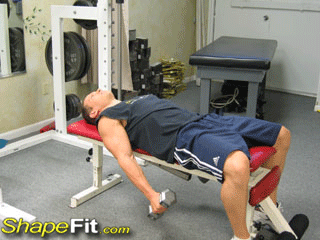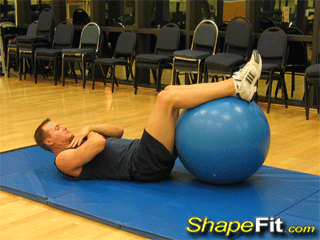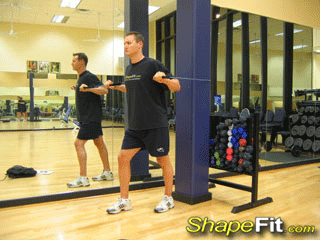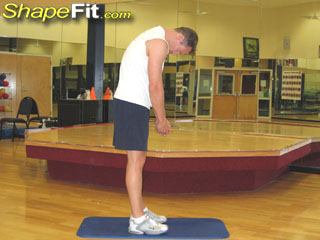Lying Dumbbell Curls – Biceps Exercise Guide
Muscles Targeted: Lying dumbbell curls, also known as lying supine dumbbell curls, is an isolation type exercise for the biceps. The word “supine” is used to describe the exercise because it is performed by lying flat on your back with your chest facing upwards. Performing this exercise works the biceps almost exclusively, especially the long head. Additional muscles that benefit from lying dumbbell curls are the brachioradialis (forearms) and the front deltoids (shoulders).

Exercise Instructions: Lie on your back on a flat bench while holding dumbbells in each hand. Allow each hand to hang as low as possible with both palms facing inward toward the bench. As you begin the movement, curl the dumbbells up and slowly twist (supinate) your wrists outward, pointing your thumbs out and your palms up as you raise the dumbbells to the top. Slowly return the dumbbells back down to the starting position and repeat.
Why This Exercise is Important: Lying dumbbell curls are considered a unique type of technique for isolating the biceps. This allows you to attain greater flexibility and growth than other more mainstream biceps exercises and are excellent when you are looking for a new exercise to spice up your arm workout. They are a good way for beginners to acquire a basic understanding of how isolation style movements truly feel when performed. This type of exercise completely isolates the biceps and does not allow for any assistance or momentum from other parts of the body. This allows for greater definition in the specific muscle being trained.
Things To Avoid: Since this is a true isolation type exercise, the biceps tendons are under relatively great stress and so you should avoid using heavy weights on this movement. Choose very light weights and really focus on your technique as you do each repetition with a slow and controlled tempo. You should avoid raising your neck, shoulders and back off of the bench to avoid injury and to put all of the stress directly on the muscles of the biceps.
Reps and Sets: The best way to approach lying dumbbell curls is to begin with a warm-up set with a very light pair of dumbbells (5-10 pounds max) and perform about 15-20 slow and steady reps. Then, for subsequent sets, select a pair of dumbbells that is slightly heavier than those with which you are comfortable with and perform 10-12 reps. It’s probably best to keep the weight of the dumbbells under 25 pounds for this exercise since anything heavier could put extra stress on your rotator cuffs (shoulders) and place them in a precarious position if your technique starts to get sloppy. Remember, this is a shaping movement to define the muscle, so make sure to go super light and keep the reps higher.
Other Exercises To Use: Here are some other exercises that you can use in conjunction with lying dumbbell curls in order to create an effective workout routine to thoroughly work your biceps. They include:
- Incline Dumbbell Curls – These are safer to perform than lying supine dumbbell curls because they do not rely solely on the upper arms being immobile for proper execution, but also use the support of the back. Thus, heavier weights can be used allowing for greater mass and strength gains. Used together with the lying curls, incline dumbbell curls offer a well-rounded biceps workout.
- Standing Barbell Curls – As far as biceps exercises are concerned, this is the granddaddy of them all for size and strength gains. Few others allow you to pack on as much weight onto the barbell as you dare to handle (with strict form). They should only be performed after warming up adequately, preferably by performing 1-2 light sets of the other exercises mentioned here.
- Single-Arm Cable Curls – Single arm cable curls have similar isolation properties to lying supine dumbbell curls without the danger of injuring your arm while retaining the ability to safely place a large load on your biceps. Remember to always warm-up properly before moving into your working sets and to stretch after training such sensitive muscles as the biceps. This reduces your recovery period, highly diminishes the chances of injury and reduces discomfort during the healing period that comes after your workout.
View our extensive database of exercise guides for a comprehensive list of exercises that target the biceps.
-
Stretching Exercise Guides with Photos and Instructions
Including stretching as a part of your overall fitness
-
Isometric Chest Press on Exercise Ball – Instructional Guide
Exercise Advice: You can either stand or sit (with you
-
Bridging – Pilates Exercise Guide with Photos
Pilates Exercise Instructions: Lie on back, knees bent
-
Dynamic Side Bridge – Core Exercise Guide with Photos
Exercise Advice: Align forearm under shoulder. Lift hi
-
Olympics Tabata Workout
Olympics Tabata Workout Tabata workouts aren’t time consuming, th
-
Bent Over Triceps Kickbacks – Elastic Bands Exercise Guide
Exercise Advice: Stand on an exercise band and slowly
- DON'T MISS
- Rotator Cuff External Rotations – Elastic Bands Exercise Guide
- One Arm Dumbbell Shoulder Press – Exercise Ball Guide
- Neck Circle Rolls – Stretching Exercise Guide with Photos
- Lunge With Two Kettlebells – Kettlebell Exercise Guide
- Seated Dumbbell Curls – Biceps Exercise Guide
- Machine Rows – Back Exercise Guide with Photos
- Side Leg Kicks – Pilates Exercise Guide with Photos
- Two Arm Hammer Dumbbell Rows – Back Exercise Guide
- Cardio Exercises to Lose Weight
- The Punch of Protein




